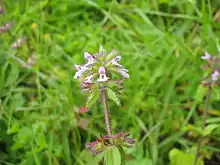Stachys arvensis
Stachys arvensis is a species of flowering plant in the mint family known by the common names field woundwort[1] and staggerweed.[2] It is native to Europe, Western Asia, and North Africa. It is known on other continents as an introduced species and widespread weed.
| Stachys arvensis | |
|---|---|
 | |
| Scientific classification | |
| Kingdom: | Plantae |
| Clade: | Tracheophytes |
| Clade: | Angiosperms |
| Clade: | Eudicots |
| Clade: | Asterids |
| Order: | Lamiales |
| Family: | Lamiaceae |
| Genus: | Stachys |
| Species: | S. arvensis |
| Binomial name | |
| Stachys arvensis | |
It grows in many types of habitat, including disturbed areas, and often in moist spots. It is an annual herb producing a branching stem up to about 60 centimeters in maximum height. The stem is squared in cross-section and it is covered in rough hairs. The oppositely arranged leaves have hairy, serrated or toothed blades up to 2 or 3 centimeters long which are borne on short petioles.
The inflorescence is made up of interrupted clusters of flowers borne in the axils of the leaf pairs. Each cluster has up to 6 flowers with pinkish corollas in hairy purple-tinged calyces of sepals.
Uses
As its common name 'field woundwort' suggests, this herb has been used since Roman times in healing wounds, and its seeds, scattered by Roman soldiers, mark the lines of Roman roads.[3] Its close relatives hedge woundwort and marsh woundwort are also used to treat wounds.
References
- "BSBI List 2007". Botanical Society of Britain and Ireland. Archived from the original (xls) on 2015-01-25. Retrieved 2014-10-17.
- "Stachys arvensis". Natural Resources Conservation Service PLANTS Database. USDA. Retrieved 30 November 2015.
- Carlton Reid (2014). "Roads Were Not Built for Cars". Island Press. p. 39
| Wikimedia Commons has media related to Stachys arvensis. |
External links
- Jepson Manual Treatment
- "Stachys arvensis". Germplasm Resources Information Network (GRIN). Agricultural Research Service (ARS), United States Department of Agriculture (USDA).
- PIER Profile
- Washington Burke Museum
- Photo gallery